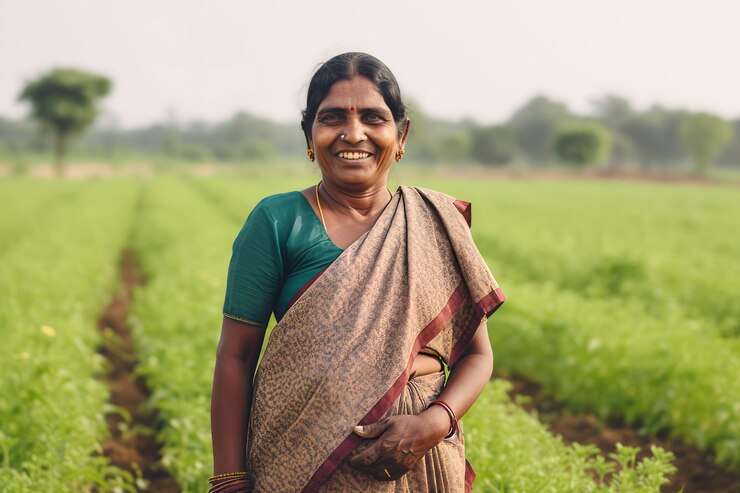TABLE OF CONTENT
ToggleINDIAN AGRICULTURE
Hey Mumbai University TYBA IDOL students! Today, we’re diving into the fascinating world of AGRICULTURE AND ITS SIGNIFICANCE INRURAL DEVELOPMENT, exploring about – “INDIAN AGRICULTURE“. We’ll be exploring two key aspects: understanding the concept of agriculture and unraveling the unique features that shape the nature of Indian agriculture. So, buckle up as we embark on a journey to discover the backbone of nations, the challenges it faced during Independence, and the remarkable features that make Indian agriculture a diverse and dynamic field.
We’ll kick things off by exploring the broad concept of agriculture – the art and science of growing crops and taking care of animals. This vast field includes crop production, animal husbandry, and more. Our journey will take us back to the period of Independence, where we’ll uncover the challenges Indian agriculture faced – from feudal land relations to traditional farming methods and the pressure of a growing population.
Moving forward, we’ll delve into the salient features that define Indian agriculture. From subsistence farming and the dependence on monsoons to the variety of crops and the significant role of animals, we’ll unravel the unique characteristics that paint a diverse picture of agriculture in our country.
So, Mumbai University TYBA IDOL students, get ready to learn about –”INDIAN AGRICULTURE” with customized idol notes just for you. Let’s make this journey into the world of agriculture an engaging and enlightening experience for everyone!


QUESTION 1:- Explain the concept of agriculture and state nature of Indian agriculture
Introduction:
At the time of India’s Independence, the agricultural landscape faced profound challenges and was shaped by various factors. This pivotal period laid the foundation for understanding the complexities that defined the nation’s agrarian sector. Let’s delve into the key facets that characterized Indian agriculture during this transformative juncture:
-
Feudal Land Relations:
- Systems like zamindari, mahalwari, and ryotwari entrenched feudal practices.
- Zamindari, particularly exploitative, posed a significant hurdle to agricultural progress.
- Peasants bore the brunt of such systems, hindering equitable development.
-
Technological Limitations:
- The sector relied heavily on traditional farming methods.
- Mechanization was minimal, and there was almost negligible use of fertilizers.
- Outdated technology impeded efficiency, resulting in low agricultural productivity.
-
Land Tenure Systems:
- Prevailing land tenure systems and exploitative practices stifled growth.
- The hierarchical nature of these systems impeded the potential for equitable land distribution.
- Agricultural development was hampered by the concentration of land ownership.
-
Subsistence Orientation:
- Agriculture was primarily subsistence-oriented.
- Small landholdings were the norm, with farmers cultivating crops for personal consumption.
- Limited engagement in commercial agriculture due to traditional practices.
-
Weather Vulnerability:
- The sector was highly dependent on monsoons for irrigation.
- Weather fluctuations posed a significant threat to agricultural output.
- Lack of alternative water sources made the sector vulnerable to climatic variations.
-
Population Pressure:
- A rapidly increasing population intensified pressure on the agricultural sector.
- The demand for food surged, necessitating innovative and sustainable farming practices.
- Agricultural practices were strained to meet the needs of a growing populace.
-
Use of Animal Power:
- Animal power played a crucial role in traditional farming operations.
- Plowing, irrigation, and other agricultural activities heavily relied on animal traction.
- The prevalent use of animal power highlighted the sector’s reliance on age-old practices.
Conclusion:
Understanding the state of Indian agriculture at Independence provides a comprehensive backdrop for appreciating the subsequent evolution and modernization efforts in the agricultural sector. This historical perspective sheds light on the challenges that paved the way for transformative changes in India’s agricultural landscape.
QUESTION 2 :- What is agriculture? Discuss the salient features of Indian agriculture
Introduction:
Agriculture, often deemed as the backbone of nations, involves the cultivation of crops and the care of animals. In India, it’s a vast field with different branches like growing crops and taking care of animals. Today, let’s unravel the diverse characteristics of Indian agriculture, understanding the challenges it faces and the unique practices it embraces.
Salient Features of Indian Agriculture:
-
Subsistence Agriculture:
- Most Indian farmers practice subsistence agriculture.
- They own small plots, work with their families, and grow crops mostly for personal use.
-
Pressure of Population:
- Indian agriculture shoulders the responsibility of feeding a growing population.
- The increasing demand for food requires more land, but urbanization encroaches on agricultural areas.
-
Dependence on Monsoon:
- Indian agriculture heavily depends on the unpredictable monsoons.
- Despite some irrigation, two-thirds of the crops rely on these rains, making farming challenging.
-
Variety of Crops:
- India’s diverse climate allows for a wide variety of crops.
- From tropical to temperate, the country boasts a range of crops suited to different regions.
-
Importance of Animals:
- Animal power plays a vital role in Indian agriculture.
- Animals are used for plowing, irrigation, threshing, and transportation, showcasing their importance.
-
Predominance of Food Crops:
- Indian agriculture gives top priority to food crops.
- Over two-thirds of cultivated land is dedicated to growing food, reflecting the focus on feeding the nation.
-
Insignificant Place for Fodder Crops:
- Despite a large livestock population, fodder crops receive minimal attention.
- Only 4% of land is devoted to permanent pastures due to the high demand for food crops.
-
Seasonal Patterns:
- Indian agriculture operates in three major seasons: Kharif, Rabi, and Zaid.
- Each season corresponds to specific crops, ensuring a continuous cycle of cultivation throughout the year.
Conclusion:
Indian agriculture is like a vibrant tapestry woven with unique characteristics. From relying on monsoons to valuing animal power and following seasonal crop patterns, these features illustrate the challenges and distinctive practices that define agriculture in India. This sector, dynamic in nature, adapts to the needs of a growing population while navigating the complexities of varied climates and land usage. It’s a testament to the resilience and adaptability of Indian farmers, who continue to contribute significantly to the nation’s food security.
Important Note for Students :– Hey everyone! All the questions in this chapter are super important!
